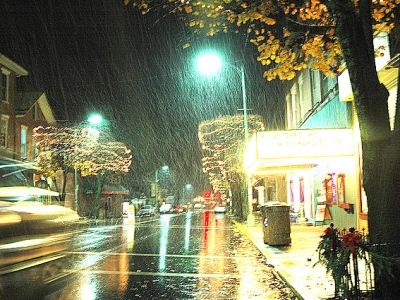WYSO, college are reunited
- Published: December 20, 2012
Antioch College will get back its longtime local radio station WYSO as part of a tentative agreement approved this week with Antioch University, which had retained control of the FM station when the College was purchased by alumni in 2009.
The boards of Antioch College and Antioch University agreed to a plan transferring the 50,000-watt, non-commercial radio station and the Charles F. Kettering Building, the 33,000-square foot building in which it operates, to Antioch College for $8 million, according to a joint press release.
Under the plan, the university also agrees to give up its claims on Antioch College’s campus or endowment, which would have reverted to the university if the college failed to receive accreditation by September 2016.
The transfer plan must be approved by the Greene County Probate Court and will take about two months to complete.
Ownership of the station and the building remained with Antioch University when the alumni-led group, the Antioch College Continuation Corporation, purchased the College and most of its assets from the university for $6.2 million in 2009, one year after the university shut down the college. At the time, university leaders said that WYSO was a key part of the university. This week, University Chancellor Felice Nudelman said that while the university wanted to retain the radio station, the sale benefits both entities.
“We still would be very keen to keep WYSO,” Nudelman said. “At the same time it helps the university, it keeps WSYO in the family, as part of the community, and ensures it a long life with the college.”
Though the cash infusion will aid the university’s bottom line, Nudelman said that the agreement did not arise from the enrollment decline and financial problems at Antioch Midwest and that the university is not undergoing financial struggles, but is in good shape with a balanced budget. Instead, the college brought up the idea of purchasing WYSO while the two groups were negotiating the removal of so-called reverter clauses from the 2009 purchase documents, Nudelman said. The university never considered selling WYSO to an outside group, she added.
“It wasn’t up for sale,” Nudelman said. “The college asked, ‘Can you include WYSO in this?’ and we felt like it was a way to help the college, even though it was hard.”
Antioch College President Mark Roosevelt said this week that bringing back the radio station was important for the college because of its symbolic significance. Started in 1958 as a student and faculty station with a 10-watt transmitter located at the student union, WYSO has grown to become the flagship NPR-affiliate in the Dayton area, reaching a potential audience of more than one million.
“The radio station, which many college folks feel a tremendous emotional allegiance to, was a very painful part of the incomplete separation,” Roosevelt said. “The Glen, The Antioch Review and WYSO are not only integral to the college but represent a substantial increase of assets to the college and to the community.”
“From our point of view, yes we had to expend some dollars and we’re not where we need to be financially, but it was well worth it to bring the radio station back and to end the entanglements,” Roosevelt said. The station’s 10 full-time and two part-time staff members will become employees of the college under the agreement.
The revived college, which has around 100 students in its second year, has been hampered by the reverter clauses, Roosevelt added. That the university might someday take over the college’s assets caused some alumni to hesitate before donating, he said. It also led to practical challenges. For example, the college could not borrow against its endowment, thereby fully utilizing the proceeds of a 2011 YSI stock sale that brought in $35 million.
While the college still intends to meet the September 2016 accreditation goal, being free of the reverter clauses means the consequences of falling short of the deadline are much less dire.
“This puts our destiny in our own hands completely,” chief communications officer Gariot Louima said this week.
The college has no plans to make changes to WYSO or to the Kettering Building at 150 E. South College St., though much of the unused space in the building could be used for college offices, Roosevelt said. The Kettering Building had been home to the Kettering Foundation’s photosynthesis research and a Battelle Memorial Institute research facility. From 1987, when the Kettering Foundation transferred the building to Antioch University, until earlier this year, it was the university’s central administration offices. In April it was remodeled to become the new home of WYSO, which moved from the college’s Sontag-Fels building.
College and university representatives declined to comment on the rationale behind the $8 million purchase price. A 2008 appraisal of WYSO completed by the university put WYSO’s value at about $4 million. Since then, WYSO has increased its wattage and the university invested at least $1 million to renovate the new studios on the first floor of the Kettering Building and spent an additional $126,000 in broadcasting equipment upgrades.
WYSO General Manager Neenah Ellis said radio station licenses can be costly, but she declined to venture a guess at the station’s value. The radio station, which was running a deficit of about $100,000 per year in 2008, according to the university, is still losing money, but its finances have improved, Ellis said.
“The university was a very good steward of WYSO,” Ellis said. “We’re in really great shape right now, we’re stronger than we’ve ever been.” Financially, “it’s no worse than it’s ever been and in some ways it’s better,” Ellis added.
Ellis said that in her four-year tenure WYSO has worked with both the college and university, hosting college Miller Fellowship interns and piloting the university’s first cross-campus online offering as part of its virtual initiative, for example.
“WYSO was going to work with everybody and have our doors open,” Ellis said. “It’s never been a problem.”
Both Roosevelt and Nudelman expressed optimism that the agreement could mean more collaboration in the future between the college and university.
“It’s in the best interest of the Yellow Springs and Dayton area to have both entities thrive,” Nudelman said. “It’s exciting that we’re both in the place where we can both succeed. We hope the community of Yellow Springs continues to support WYSO and continues to support both the college and university.”
The Yellow Springs News encourages respectful discussion of this article.
You must login to post a comment.
Don't have a login? Register for a free YSNews.com account.

Parkinsons.jpg)













No comments yet for this article.